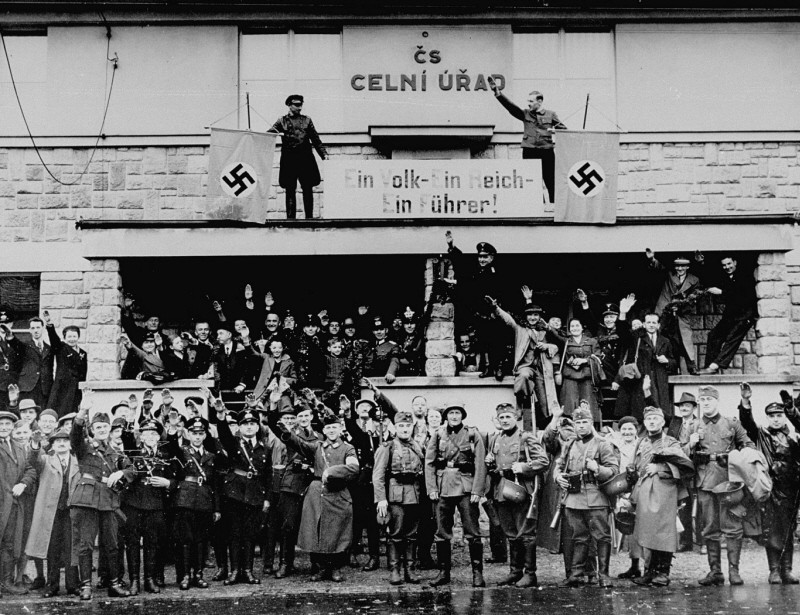
German Prewar Expansion
When Adolf Hitler became Chancellor of Germany in January 1933, he was determined to overturn the military and territorial provisions of the Treaty of Versailles. By overturning the treaty, the German government sought to incorporate ethnically German territories into the Reich. It was the first step toward the creation of a German empire in Europe.
-
1
Hitler moved to extend German power in central Europe, annexing Austria and destroying Czechoslovakia in 1938-1939. Other territorial demands followed.
-
2
Great Britain and France hoped to prevent another world war by giving into Hitler’s demands through a policy of appeasement.
-
3
Hitler's aggressive foreign policy resulted in the outbreak of World War II in September 1939.
At the Lausanne Conference of 1932, Germany, Britain, and France agreed to the formal suspension of reparations payments imposed on the defeated countries after World War I. Thus, when Adolf Hitler became chancellor of Germany in January 1933, the financial provisions of the Treaty of Versailles (the post-World War I peace agreement) had already been revised. Hitler was determined to overturn the remaining military and territorial provisions of the treaty and include ethnic Germans in the Reich as a step toward the creation of a German empire in Europe.
The German armed forces engaged in secret rearmament even before the Nazi takeover of power. Thereafter, the Nazis supported rearmament and rapidly expanded arms production. Military conscription was reintroduced on March 16, 1935, in open violation of the Treaty of Versailles. At the same time, Hitler announced the expansion of the German army to more than 500,000 men.
In the 1925 Treaty of Locarno, Germany had recognized both the inviolability of its borders with France and Belgium and the demilitarization of the Rhineland. On March 7, 1936, however, Hitler repudiated this agreement and ordered the German armed forces (Wehrmacht) into the demilitarized Rhineland. Hitler's action brought condemnation from Britain and France, but neither nation intervened.
After a prolonged period of intense propaganda inside Austria, German troops entered the country on March 12, 1938, receiving the enthusiastic support of most of the population. Austria was incorporated into Germany on the following day. In April, this German annexation was retroactively approved in a plebiscite that was manipulated to indicate that about 99 percent of the Austrian people wanted the union (known as the "Anschluss") with Germany. Neither Jews nor Roma (Gypsies) were permitted to vote in the plebiscite.

The Munich Agreement and the Partition of Czechoslovakia
In 1938, Hitler threatened to unleash a European war unless the Sudetenland, a border area of Czechoslovakia containing an ethnic German majority, was surrendered to Germany. The leaders of Britain, France, Italy, and Germany held a conference in Munich, Germany, on September 29-30, 1938, in which they agreed to the German annexation of the Sudetenland in exchange for a pledge of peace from Hitler. Czechoslovakia, which was not a party to the Munich negotiations, agreed under significant pressure from Britain and France.
On March 15, 1939, Hitler violated the Munich agreement and moved against the Czechoslovak state. The Czech provinces of Bohemia and Moravia were proclaimed a German protectorate and were occupied by German forces. Slovakia became an independent state, closely allied with Germany. Hungary, which had annexed territory in southern Slovakia after the Munich conference, seized the Transcarpathian Ukraine. Czechoslovakia ceased to exist.
Little more than a week later, on March 23, 1939, German troops suddenly occupied Memel. Lithuania was unable to prevent this occupation. Hitler also raised territorial demands on Poland in the spring of 1939. He demanded the annexation of the Free City of Danzig to Germany and extraterritorial access for Germany through the so-called Polish Corridor to East Prussia.
Convinced that Hitler would not negotiate in good faith, Britain and France guaranteed the integrity of Polish territory against German aggression. With Hitler determined to attack Poland, Europe was on the brink of war in late summer 1939.
Critical Thinking Questions
- Many of the actions of the German government violated previous agreements and treaties. How did other governments respond?
- What alternatives do other countries and the world community as a whole have when a nation violates or ignores the requirements of a treaty or agreement?